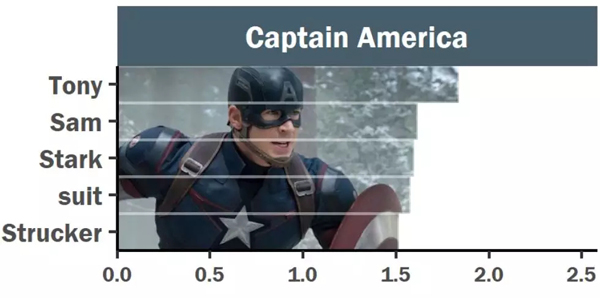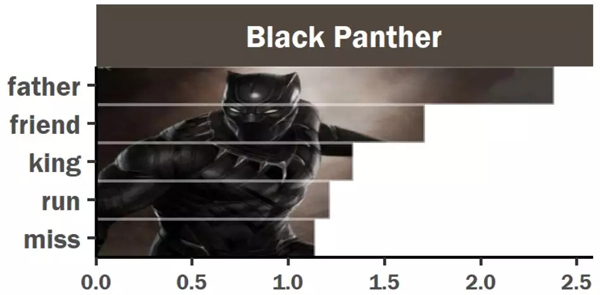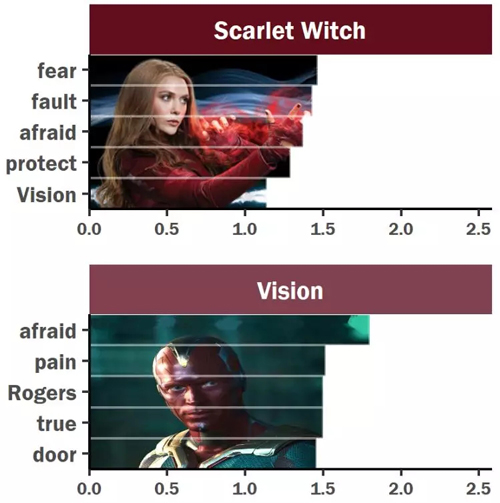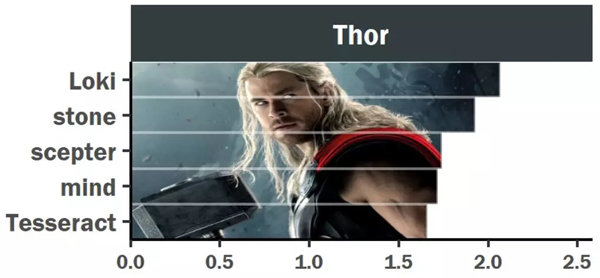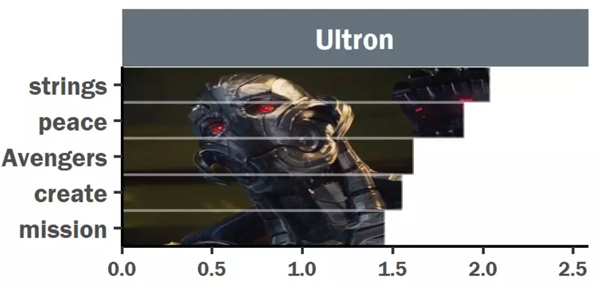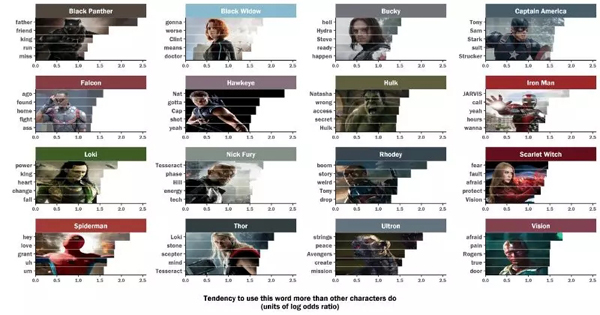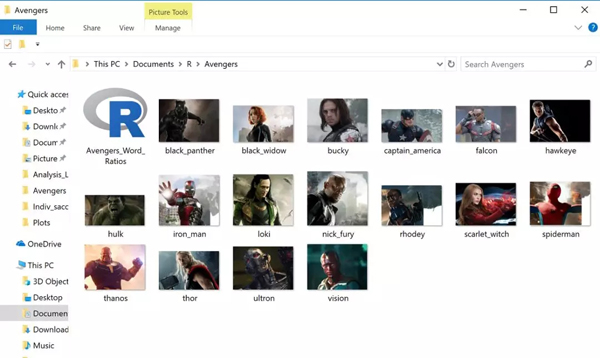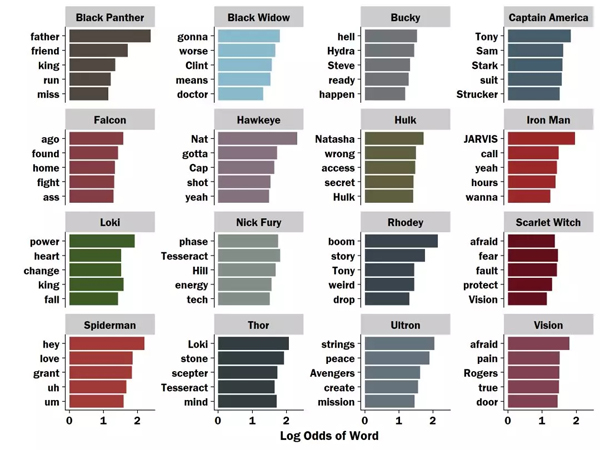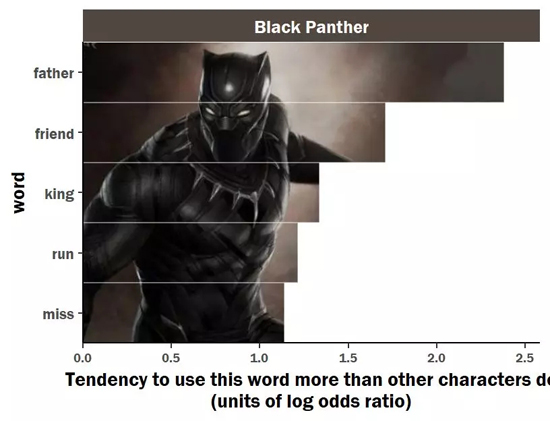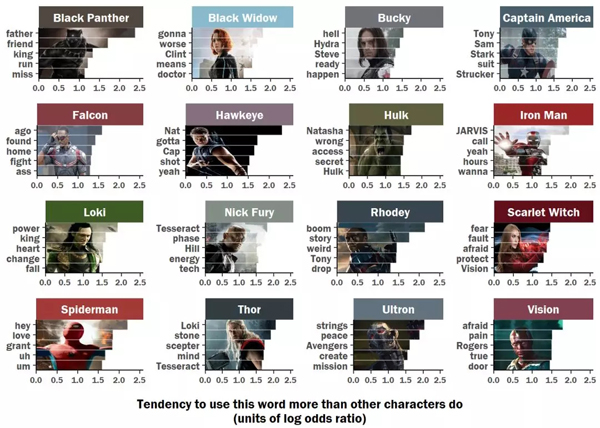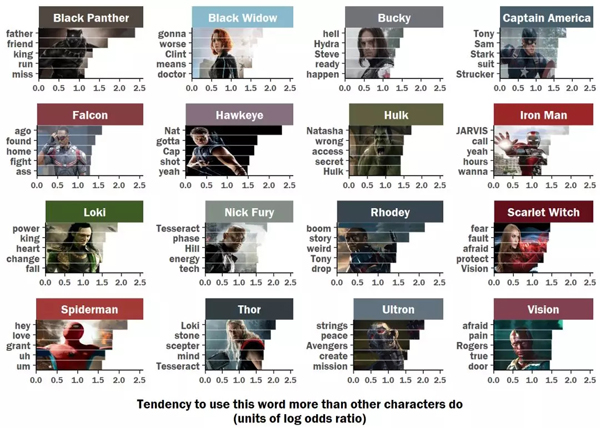我們分析了復仇者聯盟系列所有臺詞,看看英雄們都愛說什么?沒有劇透!
大數據文摘出品
作者:蔣寶尚、魏子敏
《復仇者聯盟4》終于上映,這部匯集了10年回憶打造的電影,據看過的小伙伴們表示:3小時劇情,毫無尿點,全程都是經典回憶。
忙著工作還沒來得及看電影,又超怕被劇透的文摘菌這兩天的狀態基本是這樣👇
萬般捉急的文摘菌在這周也去重新回憶了一下這個系列的作品。這部電影是復仇者系列的終結作品,能有如此成就,離不開《鋼鐵俠》、《美國隊長》,《雷神》、《綠巨人》等獨立敘事電影為其構建的宏大的宇宙觀,也在全球觀眾心里種下同一種英雄情結。
復仇者系列火遍全球絕非意外,這部作品盡管出現了各種人物,但是每個英雄又都被塑造地各具特色,讓人一次就能記住。
而臺詞可以說是最能塑造人物性格的部分了。因此,文摘菌希望用數據分析的方式,看看漫威宇宙的英雄喜歡用的詞匯可視化,并通過此分析他們的人物特點,向這部偉大的作品致敬。
本次分析,我們主要使用了R語言進行編程,目的是找出最能代表每位英雄的詞匯。數據選用了三個比較有代表性的漫威英雄交叉度極高的劇本,分別是:《復仇者聯盟》(就是打洛基的那一部)、《復仇者聯盟:奧創紀元》以及《美國隊長:內戰》。
上代碼前,先來看看分析結果。
1. 美國隊長:以你的名字呼喚你-鋼鐵俠!
作為聯盟的老大哥,美國隊長超愛喊別人的名字。并且我們發現,他口中最經常出現的名字就是鋼鐵俠。此外,還經常點名的是Sam,和Strucker。
美國隊長和鋼鐵俠可謂《復仇者聯盟》系列中兩大相愛相殺的主角了。兩人在電影中都是領導級別的角色,但是兩者的追求卻有很大的差異。在電影《美國隊長:內戰》中,復仇者聯盟團隊徹底分崩離析,分別從屬了美國隊長和鋼鐵俠兩大陣營。
一方面美國隊長為了自己的好朋友冬兵戰斗,另一方鋼鐵俠為了維護世界的秩序和為自己的父母報仇戰斗。兩者即是好友,又是同級別的對手,這或許也就解釋了為什么美國隊長總是叫鋼鐵俠的名字。
2. 黑豹:最喜歡談論“中二“話題的貴族
從分析結果來看,黑豹最喜歡說的是父親、朋友,國王等聽起來比較“中二“的詞語。
黑豹的父親前任黑豹特查卡,瓦坎達的國王!守護者振金,是黑豹的偶像,卻在電影中死于一場陰謀。而黑豹作為瓦坎達的年輕的王位繼承人,將他父親的遺志作為了追求的夢想,守護著瓦坎達。國王身份,追求理想,這就是黑豹喜歡談論這類貴族話題的原因。
3. 蜘蛛俠:我還是個“寶寶“。
作為全隊的“小朋友“,蜘蛛俠在復仇者聯盟系列電影中的臺詞一直比較幼齒,他在電影中說的最多的是詞是:“嗨”、“呃”、“嗯”。
在這三部電影中,蜘蛛俠只是一個十幾歲的孩子,在這么多大人物面前如果再不蹦蹦跳跳,那就更沒有存在感了☺。
4. 浩克和鷹眼:大家都愛黑寡婦。
通過可視化分析可以發現,綠巨人和鷹眼都非常喜歡提到黑寡婦。
浩克喜歡和黑寡婦聊天原因很簡單,因為當綠巨人發狂時,黑寡婦用滿心關愛的眼神瞅著他那龐大的身軀,對他說道:“嘿,大塊頭,太陽快下山了!”然后慢慢地舉起了手,用她那柔軟的手指,伸向了綠巨人的手臂,輕輕滑了下來。這時候浩克就會平息他那滿腔的怒火!
電影中黑寡婦和鷹眼不是戀人或者情侶,他們的關系一直戀人未滿、曖昧不清。但是,因為兩人在復仇者聯盟之前就已經發生了一系列故事。刀光劍影,愛恨情仇,即是老友又是戰友,或許兩人早已暗生情愫。
5. 幻世和緋紅女巫:惺惺相惜,在線發糖!
從數據可視化的結果中可以看到,幻視和緋紅女巫絕對是soulmate了,兩人的談論內容都很一致,特別喜歡說“恐懼、擔憂“類話題!
關于緋紅女巫,我們可以從她童年的經歷和非人的待遇中找到原因。而幻世作為超級人工智能,能夠看到別的英雄看不到的“畫面”,可能對未來的擔憂讓他心煩意亂。
6. 托爾:能力越大,責任越大,考慮深遠
托爾作為雷神,擁有多種魔法能力,例如:操控風暴,釋放或控制閃電,將閃電能量實體化為盔甲,瞬間改變天氣,利用雷神之錘飛行,召喚雷神之錘令其飛回托爾用閃電與敵人交戰。
雷神除去強大的戰斗力,托爾還掌握著星際級的知識。例如:寶石知識、各式星際飛船駕駛技術、格魯特語(格魯特所在種族的語言)、蟲洞知識。
或許是能力越大,責任越大,他比其他英雄角色看的更遠。在電影中,他對推動劇情前進的物品更加專注,例如洛基的權杖以及心靈寶石。
7. 洛基:追逐權力。
洛基從小和雷神托爾一起長大。一直窺視眾神之王的寶座且不認同雷神托爾會是一位合格的繼承人。他野心十足想當老大,陰險狡詐陷害兄長、反逆父母,視天下生命如草芥,為了目的不擇手段。
總之一句話,他非常想要權力!
8. 奧創:更愛“詩和遠方“。
奧創被制造出來的目的是為了守護和平,但是一誕生就發生錯誤,認為想要和平就要消滅人類和復仇者聯盟,于是搶走洛基權杖(心靈寶石)從尤利西斯·克勞手中弄到大量的振金,操縱趙海倫利用再生搖籃幫其制造幻視身體,想要進化得更強。
換句話說,奧創一出生就被訂上了守護和平的烙印,雖然他看問題的角度不同,但是和復仇者聯盟有著共同的任務。所以,它更加向往詩與遠方!
上面條條的長度對應的是超級英雄使用每個詞匯的程度。
可視化過程
最后,分析完全劇的角色,我們也來一起看看整個可視化過程。
導入R語言包:
- library(dplyr)
- library(grid)
- library(gridExtra)
- library(ggplot2)
- library(reshape2)
- library(cowplot)
- library(jpeg)
- library(extrafont)
清除R工作環境中的全部東西:
- rm(list = ls())
加載包含所有圖片的文件夾(根據你自己的情況修改代碼):
- dir_images <- "C:\\Users\\Matt\\Documents\\R\\Avengers"
- setwd(dir_images)
設置字體:
- windowsFonts(Franklin=windowsFont("Franklin Gothic Demi"))
英雄角色名字的簡化版本:
- character_names <- c("black_panther","black_widow","bucky","captain_america",
- "falcon","hawkeye","hulk","iron_man",
- "loki","nick_fury","rhodey","scarlet_witch",
- "spiderman","thor","ultron","vision")
- image_filenames <- paste0(character_names, ".jpg")
將所有圖片讀入一個列表中。
- all_images <- lapply(image_filenames, read_image)
將角色名字分配給圖像列表,以便按名字對其進行索引。
- names(all_images) <- character_names
例如:
- # clear the plot window
- grid.newpage()
- # draw to the plot window
- grid.draw(rasterGrob(all_images[['vision']]))
獲得文本數據
數據由計算機科學家Elle O'Brien收集的,使用文本挖掘技術對電影劇本分析。
更正專有名稱的大寫:
- capitalize <- Vectorize(function(string){
- substr(string,1,1) <- toupper(substr(string,1,1))
- return(string)
- })
- proper_noun_list <- c("clint","hydra","steve","tony",
- "sam","stark","strucker","nat","natasha",
- "hulk","tesseract", "vision",
- "loki","avengers","rogers", "cap", "hill")
- # Run the capitalization function
- word_data <- word_data %>%
- mutate(word = ifelse(word %in% proper_noun_list, capitalize(word), word)) %>%
- mutate(word = ifelse(word == "jarvis", "JARVIS", word))
請注意,以前的簡版角色名字與文本dataframe格式中的角色不匹配。
- unique(word_data$Speaker)
- ## [1] "Black Panther" "Black Widow" "Bucky"
- ## [4] "Captain America" "Falcon" "Hawkeye"
- ## [7] "Hulk" "Iron Man" "Loki"
- ## [10] "Nick Fury" "Rhodey" "Scarlet Witch"
- ## [13] "Spiderman" "Thor" "Ultron"
- ## [16] "Vision"
創建一個索引表,將文件名轉換為角色名。
- character_labeler <- c(`black_panther` = "Black Panther",
- `black_widow` = "Black Widow",
- `bucky` = "Bucky",
- `captain_america` = "Captain America",
- `falcon` = "Falcon", `hawkeye` = "Hawkeye",
- `hulk` = "Hulk", `iron_man` = "Iron Man",
- `loki` = "Loki", `nick_fury` = "Nick Fury",
- `rhodey` = "Rhodey",`scarlet_witch` ="Scarlet Witch",
- `spiderman`="Spiderman", `thor`="Thor",
- `ultron` ="Ultron", `vision` ="Vision")
有兩個不同版本的角色名,一個用于顯示(漂亮),一個用于索引(簡單)。
- convert_pretty_to_simple <- Vectorize(function(pretty_name){
- # pretty_name = "Vision"
- simple_name <- names(character_labeler)[character_labeler==pretty_name]
- # simple_name <- as.vector(simple_name)
- return(simple_name)
- })
- # convert_pretty_to_simple(c("Vision","Thor"))
- # just for fun, the inverse of that function
- convert_simple_to_pretty <- function(simple_name){
- # simple_name = "vision"
- pretty_name <- character_labeler[simple_name] %>% as.vector()
- return(pretty_name)
- }
- # example
- convert_simple_to_pretty(c("vision","black_panther"))
- ## [1] "Vision" "Black Panther"
將簡化的角色名稱添加到文本數據框架中。
- word_data$character <- convert_pretty_to_simple(word_data$Speaker)
為每個角色指定主顏色:
- character_palette <- c(`black_panther` = "#51473E",
- `black_widow` = "#89B9CD",
- `bucky` = "#6F7279",
- `captain_america` = "#475D6A",
- `falcon` = "#863C43", `hawkeye` = "#84707F",
- `hulk` = "#5F5F3F", `iron_man` = "#9C2728",
- `loki` = "#3D5C25", `nick_fury` = "#838E86",
- `rhodey` = "#38454E",`scarlet_witch` ="#620E1B",
- `spiderman`="#A23A37", `thor`="#323D41",
- `ultron` ="#64727D", `vision` ="#81414F" )
繪制條形圖☟
- avengers_bar_plot <- word_data %>%
- group_by(Speaker) %>%
- top_n(5, amount) %>%
- ungroup() %>%
- mutate(word = reorder(word, amount)) %>%
- ggplot(aes(x = word, y = amount, fill = character))+
- geom_bar(stat = "identity", show.legend = FALSE)+
- scale_fill_manual(values = character_palette)+
- scale_y_continuous(name ="Log Odds of Word",
- breaks = c(0,1,2)) +
- theme(text = element_text(family = "Franklin"),
- # axis.title.x = element_text(size = rel(1.5)),
- panel.grid = element_line(colour = NULL),
- panel.grid.major.y = element_blank(),
- panel.grid.minor = element_blank(),
- panel.background = element_rect(fill = "white",
- colour = "white"))+
- # theme(strip.text.x = element_text(size = rel(1.5)))+
- xlab("")+
- coord_flip()+
- facet_wrap(~Speaker, scales = "free_y")
- avengers_bar_plot
這已經非常漂亮了,但是還可以更漂亮。比如人物形象通過“線條”顯示出來。具體做法是將透明的條形圖全覆蓋,然后從端點向里繪制白色的條形圖,注意條形圖是能夠遮擋圖片的。
在數據框架中,用達到總值所需的余數來補充數值,這樣當將值和余數組合在一起時,就會形成長度一致的線條組合。
- max_amount <- max(word_data$amount)
- word_data$remainder <- (max_amount - word_data$amount) + 0.2
每個英雄角色僅提取5個關鍵詞。
- word_data_top5 <- word_data %>%
- group_by(character) %>%
- arrange(desc(amount)) %>%
- slice(1:5) %>%
- ungroup()
將“amount”和“remaining”的格式進行轉換:
確保每個角色有兩個長條;一個用于顯示amount,另一個用于選擇結束位置。
這會將“amount”和“remaining”折疊成一個名為“variable”的列,指示它是哪個值,另一列“value”包含每個值中的數字。
- word_data_top5_m <- melt(word_data_top5, measure.vars = c("amount","remainder"))
將這些條形圖放在有序因素中,與在數據融合中相反。否則,“amount”和“remainder”將在圖上以相反的順序顯示。
- word_data_top5_m$variable2 <- factor(word_data_top5_m$variable,
- levels = rev(levels(word_data_top5_m$variable)))
每個角色僅僅顯示五個詞匯
注意角色名稱的版本問題,例如采用“black_panther”而不是“Black Panther”。
- plot_char <- function(character_name){
- # example: character_name = "black_panther"
- # plot details that we might want to fiddle with
- # thickness of lines between bars
- bar_outline_size <- 0.5
- # transparency of lines between bars
- bar_outline_alpha <- 0.25
- #
- # The function takes the simple character name,
- # but here, we convert it to the pretty name,
- # because we'll want to use that on the plot.
- pretty_character_name <- convert_simple_to_pretty(character_name)
- # Get the image for this character,
- # from the list of all images.
- temp_image <- all_images[character_name]
- # Make a data frame for only this character
- temp_data <- word_data_top5_m %>%
- dplyr::filter(character == character_name) %>%
- mutate(character = character_name)
- # order the words by frequency
- # First, make an ordered vector of the most common words
- # for this character
- ordered_words <- temp_data %>%
- mutate(word = as.character(word)) %>%
- dplyr::filter(variable == "amount") %>%
- arrange(value) %>%
- `[[`(., "word")
- # order the words in a factor,
- # so that they plot in this order,
- # rather than alphabetical order
- temp_data$word = factor(temp_data$word, levels = ordered_words)
- # Get the max value,
- # so that the image scales out to the end of the longest bar
- max_value <- max(temp_data$value)
- fill_colors <- c(`remainder` = "white", `value` = "white")
- # Make a grid object out of the character's image
- character_image <- rasterGrob(all_images[[character_name]],
- width = unit(1,"npc"),
- height = unit(1,"npc"))
- # make the plot for this character
- output_plot <- ggplot(temp_data)+
- aes(x = word, y = value, fill = variable2)+
- # add image
- # draw it completely bottom to top (x),
- # and completely from left to the the maximum log-odds value (y)
- # note that x and y are flipped here,
- # in prep for the coord_flip()
- annotation_custom(character_image,
- xmin = -Inf, xmax = Inf, ymin = 0, ymax = max_value) +
- geom_bar(stat = "identity", color = alpha("white", bar_outline_alpha),
- size = bar_outline_size, width = 1)+
- scale_fill_manual(values = fill_colors)+
- theme_classic()+
- coord_flip(expand = FALSE)+
- # use a facet strip,
- # to serve as a title, but with color
- facet_grid(. ~ character, labellerlabeller = labeller(character = character_labeler))+
- # figure out color swatch for the facet strip fill
- # using character name to index the color palette
- # color= NA means there's no outline color.
- theme(strip.background = element_rect(fill = character_palette[character_name],
- color = NA))+
- # other theme elements
- theme(strip.text.x = element_text(size = rel(1.15), color = "white"),
- text = element_text(family = "Franklin"),
- legend.position = "none",
- panel.grid = element_blank(),
- axis.text.x = element_text(size = rel(0.8)))+
- # omit the axis title for the individual plot,
- # because we'll have one for the entire ensemble
- theme(axis.title = element_blank())
- return(output_plot)
- }
單個角色是如何設置?
- sample_plot <- plot_char("black_panther")+
- theme(axis.title = element_text())+
- # x lab is still declared as y lab
- # because of coord_flip()
- ylab(plot_x_axis_text)
- sample_plot
橫軸為什么這么特殊?因為隨著數值的增加,條形圖會變得越來越高,因此需要轉換刻度。
如下所示☟
- logit2prob <- function(logit){
- odds <- exp(logit)
- prob <- odds / (1 + odds)
- return(prob)
- }
…這就是這個軸的樣子:
- logit2prob(seq(0, 2.5, 0.5))
- ## [1] 0.5000000 0.6224593 0.7310586 0.8175745 0.8807971 0.9241418
注意該列表中連續項之間的遞減差異:
- diff(logit2prob(seq(0, 2.5, 0.5)))
- ## [1] 0.12245933 0.10859925 0.08651590 0.06322260 0.04334474
好了,可以進行下一項了:探討一些細節,并把上面設置的函數應用到所有角色的列表中,并把所有的結果放入一個列表中。
- all_plots <- lapply(character_names, plot_char)
從圖片中提取標題
- get_axis_grob <- function(plot_to_pick, which_axis){
- # plot_to_pick <- sample_plot
- tmp <- ggplot_gtable(ggplot_build(plot_to_pick))
- # tmp$grobs
- # find the grob that looks like
- # it would be the x axis
- axis_x_index <- which(sapply(tmp$grobs, function(x){
- # for all the grobs,
- # return the index of the one
- # where you can find the text
- # "axis.title.x" or "axis.title.y"
- # based on input argument `which_axis`
- grepl(paste0("axis.title.",which_axis), x)}
- ))
- axis_grob <- tmp$grobs[[axis_x_index]]
- return(axis_grob)
- }
提取軸標題:
- px_axis_x <- get_axis_grob(sample_plot, "x")
- px_axis_y <- get_axis_grob(sample_plot, "y")
下面是如何使用提取出來的坐標軸:
- grid.newpage()
- grid.draw(px_axis_x)
- # grid.draw(px_axis_y)
匯總所有的英雄:
- big_plot <- arrangeGrob(grobs = all_plots)
加入圖注,注意圖和坐標軸的比例關系:
- big_plot_w_x_axis_title <- arrangeGrob(big_plot,
- px_axis_x,
- heights = c(10,1))
- grid.newpage()
- grid.draw(big_plot_w_x_axis_title)
因為詞匯的長度不同,這些圖表占用的頁面空間略有不同。
所以,這看起來有點亂。
一般來說,我們使用facet_grid()或facet_wrap()確保在繪圖的過程中保持整齊和對齊,這個項目中不再適用,因為每個都有自己的自定義背景圖像。
使用Cowplot而不是arrangebrob,讓圖片的軸垂直對齊:
- big_plot_aligned <- cowplot::plot_grid(plotlist = all_plots, align = 'v', nrow = 4)
增加X軸的標題,和之前類似,注意網格對齊:
- big_plot_w_x_axis_title_aligned <- arrangeGrob(big_plot_aligned,
- px_axis_x,
- heights = c(10,1))
然后,大功告成☟
然后,保存一下!
ggsave(big_plot_w_x_axis_title_aligned, file = "Avengers_Word_Usage.png", width = 12, height = 6.3)
相關報道:
- https://towardsdatascience.com/i-analyzed-marvel-movie-scripts-to-learn-what-each-avenger-says-most-2e5e7b6105bf
- http://mattwinn.com/Plot_Avengers_data.html
【本文是51CTO專欄機構大數據文摘的原創文章,微信公眾號“大數據文摘( id: BigDataDigest)”】














